London
From Wikipedia, the free encyclopedia
This article is about the capital of England and the United Kingdom. For other uses, see London (disambiguation).
London is a leading global city, with strengths in the arts, commerce, education, entertainment, fashion, finance, healthcare, media, professional services, research and development, tourism and transport all contributing to its prominence.[11] It is the world's largest financial centre alongside New York,[12][13][14] has the largest city GDP in Europe[15] and is home to the headquarters of more than 100 of Europe's 500 largest companies.[16] It is the most visited city by international tourists in the world.[17] London's five international airports make its airspace the busiest of any urban centre worldwide[18][not in citation given] and London Heathrow is the world's busiest airport by number of international passengers.[19][non-primary source needed] London's 43 universities form the largest concentration of higher education institutions in Europe.[20] In 2012 London will become the first city to host the Summer Olympics three times.[21] The same year it will host the Paralympic Games for the first time.
London has a diverse range of peoples, cultures and religions, and more than 300 languages are spoken within its boundaries.[22] In July 2007 it had an official population of 7,556,900 within the boundaries of Greater London,[23] making it the most populous municipality in the European Union.[24] The Greater London Urban Area is the second largest in the EU with a population of 8,278,251,[2] while London's metropolitan area is the largest in the EU with an estimated total population of between 12 million[3] and 14 million.[4]
London contains four World Heritage Sites: the Tower of London; Kew Gardens; the site comprising the Palace of Westminster, Westminster Abbey and St. Margaret's Church; and the historic settlement of Greenwich (in which the Royal Observatory marks the Greenwich Meridian (0° longitude) and GMT).[25] Other famous landmarks include Buckingham Palace, the London Eye, Piccadilly Circus, 30 St Mary Axe ("The Gherkin"), St Paul's Cathedral, Tower Bridge and Trafalgar Square. London is home to numerous museums, galleries, libraries, sporting events and other cultural institutions including the British Museum, National Gallery, British Library, Wimbledon and 40 theatres.[26] London's Chinatown is the largest in Europe.[27] The London Underground network is the oldest underground railway network in the world[28] and the most extensive after the Shanghai Metro.[29]
Contents |
History
Main article: History of London
Toponomy

The name London may derive from the River Thames
From 1899 it was commonly accepted that the name was of Celtic origin and meant place belonging to a man called *Londinos; this explanation has since been rejected.[30] Richard Coates put forward an explanation in 1998 that it is derived from the pre-Celtic Old European *(p)lowonida, meaning 'river too wide to ford', and suggested that this was a name given to the part of the River Thames which flows through London; from this, the settlement gained the Celtic form of its name, *Lowonidonjon.[32] Until 1889 the name officially only applied to the City of London but since then it has also referred to the County of London and now Greater London.[7]
The Welsh word for London is Llundain from Middle Welsh Llundein[33] and the Welsh u descends from either proto-Celtic oi or ou.[34] As with the Romano-British theonym Nodons from *Noudont- ",[35] Celtic ou was sometimes transcribed as Latin o. According to established Celtic sound change laws,[34] if Llundain were descended from a former *Londiniom, we would expect to see *Llondyn or *Llyndyn in Welsh, but a hypothetical *Lou-nd-e-njo-m would yield Welsh Llundain according to the same sound change principles.[34] The element *lou- is a widely attested Proto-Indo-European root meaning ‘wash’.[36][37][38][39]
Prehistory and antiquity
Although there is evidence of scattered Brythonic settlements in the area, the first major settlement was founded by the Romans in 43 AD.[40] This lasted for just seventeen years and around 61, the Iceni tribe led by Queen Boudica stormed it, burning it to the ground.[41] The next, heavily planned incarnation of the city prospered and superseded Colchester as the capital of the Roman province of Britannia in 100. At its height during the 2nd century, Roman London had a population of around 60,000. By the 7th century, the Anglo-Saxons had created a new settlement called Lundenwic over a mile (2 km) upstream from the old Roman city, around what is now Covent Garden.[42]It is likely that there was a harbour at the mouth of the River Fleet for fishing and trading, and this trading grew, until the city was overcome by the Vikings and forced to move east, back to the location of the Roman Londinium, in order to use its walls for protection.[43] Viking attacks continued to increase, until 886 when Alfred the Great recaptured London and made peace with the Danish leader, Guthrum.[44] The original Saxon city of Lundenwic became Ealdwic ("old city"), a name surviving to the present day as Aldwych, which is in the modern City of Westminster.[45]
Middle Ages
With the collapse of Roman rule in the early 5th century, London was effectively abandoned. However, from the 6th century an Anglo-Saxon settlement known as Lundenwic developed slightly to the west of the old Roman city, around what is now Covent Garden and the Strand, rising to a likely population of 10–12,000.[42] In the 9th century London was repeatedly attacked by Vikings, leading to a relocation of the city back to the location of Roman Londinium, in order to use its walls for protection.[43] Following the unification of England in the 10th century London, already the country's largest city and most important trading centre, became increasingly important as a political centre, although it still faced competition from Winchester, the traditional centre of the kingdom of Wessex.
Westminster Abbey is a World Heritage Site and one of London's oldest and most important buildings as seen in this painting (Canaletto, 1749 A.D.)
Following his victory in the Battle of Hastings, William, Duke of Normandy, was crowned King of England in the newly finished Westminster Abbey on Christmas Day 1066.[47] William constructed the Tower of London, the first of the many Norman castles in England to be rebuilt in stone, in the southeastern corner of the city to intimidate the native inhabitants.[48] In 1097, William II began the building of Westminster Hall, close by the abbey of the same name. The hall became the basis of a new Palace of Westminster.[49][50]
During the 12th century the institutions of central government, which had hitherto accompanied the royal court as it moved around the country, grew in size and sophistication and became increasingly fixed in one place. In most cases this was Westminster, although the royal treasury, having been moved from Winchester, came to rest in the Tower. While the City of Westminster developed into a true capital in governmental terms, its distinct neighbour, the City of London, remained England's largest city and principal commercial centre and flourished under its own unique administration, the Corporation of London. In 1100 its population was around 18,000; by 1300 it had grown to nearly 100,000.[51]
Disaster struck during the Black Death in the mid-14th century, when London lost nearly a third of its population.[52] Apart from the invasion during the Peasants' Revolt in 1381,[53] London remained relatively untouched by the various civil wars during the Middle Ages.[citation needed]
Early modern
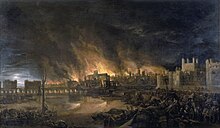
The Great Fire of London destroyed many parts of the city in 1666.
In the 16th century William Shakespeare and his contemporaries lived in London at a time of hostility to the development of the theatre. By the end of the Tudor period in 1603, London was still very compact. There was an assassination attempt on James I in Westminster, through the Gunpowder Plot on 5 November 1605.[55] London was plagued by disease in the early 17th century,[56] culminating in the Great Plague of 1665–1666, which killed up to 100,000 people, or a fifth of the population.[57]
The Great Fire of London broke out in 1666 in Pudding Lane in the city and quickly swept through the wooden buildings.[58] Rebuilding took over ten years and was supervised by Robert Hooke[59][60][61] as Surveyor of London.[62] In 1708 Christopher Wren's masterpiece, St. Paul's Cathedral was completed. During the Georgian era new districts such as Mayfair were formed in the west; and new bridges over the Thames encouraged development in South London. In the east, the Port of London expanded downstream.
In 1762 George III acquired Buckingham House and it was enlarged over the next 75 years. During the 18th century, London was dogged by crime and the Bow Street Runners were established in 1750 as a professional police force.[63] In total, more than 200 offenses were punishable by death,[64] and women and children were hanged for petty theft.[65] Over 74 per cent of children born in London died before they were five.[66] The coffee house became a popular place to debate ideas, with growing literacy and the development of the printing press making news widely available; and Fleet Street became the centre of the British press.
“ You find no man, at all intellectual, who is willing to leave London. No, Sir, when a man is tired of London, he is tired of life; for there is in London all that life can afford. ”
Late modern and contemporary

A London street hit during the Blitz of World War II
In 1951 the Festival of Britain was held on the South Bank. The Great Smog of 1952 led to the Clean Air Act 1956, which ended the "pea-souper" fogs for which London had been notorious. From the 1950s onwards, London became home to a large number of immigrants, largely from Commonwealth countries such as Jamaica, India, Bangladesh and Pakistan, making London one of the most diverse cities in Europe.
Starting in the mid-1960s, London became a centre for the worldwide youth culture, exemplified by the Swinging London subculture associated with Carnaby Street. The role of trendsetter was revived during the punk era. In 1965 London's political boundaries were expanded to take into account the growth of the urban area and a new Greater London Council was created. During The Troubles in Northern Ireland, London was subjected to bombing attacks by the Provisional IRA. Racial inequality was highlighted by the 1981 Brixton riot. Greater London's population declined steadily in the decades after World War II, from an estimated peak of 8.6 million in 1939 to around 6.8 million in the 1980s. The principal ports for London moved downstream to Felixstowe and Tilbury, with the London Docklands area becoming a focus for regeneration.
The Thames Barrier was completed in the 1980s to protect London against tidal surges from the North Sea. The Greater London Council was abolished in 1986, which left London as the only large metropolis in the world without a central administration. In 2000, London-wide government was restored, with the creation of the Greater London Authority. To celebrate the start of the 21st century, the Millennium Dome, London Eye and Millenium Bridge were constructed. On 7 July 2005, several London Underground trains and a bus were bombed in a series of terrorist attacks.[71]
Government
Local government
Main articles: Local government in London, History of local government in London, and List of heads of London government
The administration of London is formed of two tiers—a city-wide, strategic tier and a local tier. City-wide administration is coordinated by the Greater London Authority (GLA), while local administration is carried out by 33 smaller authorities.[72] The GLA consists of two elected components; the Mayor of London, who has executive powers, and the London Assembly, who scrutinise the mayor's decisions and can accept or reject his budget proposals each year. The headquarters of the GLA is City Hall, Southwark; the current mayor is Boris Johnson. The mayor's statutory planning strategy is published as the London Plan, which as of mid-2009 is being revised, for final publication in 2011. The local authorities are the councils of the 32 London boroughs and the City of London Corporation.[73] They are responsible for most local services, such as local planning, schools, social services, local roads and refuse collection. Certain functions, such as waste management, are provided through joint arrangements.Policing in Greater London, with the exception of the City of London, is provided by the Metropolitan Police Force, overseen by the Metropolitan Police Authority. The City of London has its own police force – the City of London Police.[74] The British Transport Police are responsible for police services on National Rail and London Underground services in the capital.[75]
The London Fire Brigade is the statutory fire and rescue service for Greater London. It is run by the London Fire and Emergency Planning Authority and is the third-largest fire service in the world.[76] National Health Service ambulance services are provided by the London Ambulance Service (LAS) NHS Trust, the largest free at the point of use emergency ambulance service in the world.[77] The London Air Ambulance charity operates in conjunction with the LAS where required. Her Majesty's Coastguard and the Royal National Lifeboat Institution operate on the River Thames.[78][79]
National government
London is the seat of the Government of the United Kingdom, which is located around the Palace of Westminster. Many government departments are located close to Parliament, particularly along Whitehall, including the Prime Minister's residence at 10 Downing Street.[80] The British Parliament is often referred to as the "Mother of Parliaments" (although this sobriquet was first applied to England itself by John Bright)[81] because it has been the model for most other parliamentary systems, and its Acts have created many other parliaments.Geography
Main article: Geography of London
Scope
Greater London is the top-level administrative subdivision covering London. The small, ancient City of London at its core once contained the whole settlement, but as the urban area grew the City Corporation resisted attempts to amalgamate it with its suburbs, causing "London" to be defined in a number ways for different purposes; and the situation was once open to legal debate.[82] Forty per cent of Greater London is covered by the London post town, within which 'LONDON' forms part of postal addresses.[83][84]The London telephone area code (020) covers a larger area, similar in size to Greater London, although some outer districts are omitted and some places just outside are included. The area within the orbital M25 motorway is normally what is referred to as 'London'.[85] and the Greater London boundary has been aligned to it in places.[86]
Outward urban expansion is now prevented by the Metropolitan Green Belt,[87] although the built-up area extends beyond the boundary in places, resulting in a separately defined Greater London Urban Area. Beyond this is the vast London commuter belt.[88] Greater London is split for some purposes into Inner London and Outer London.[89] The city is split by the River Thames into North and South, with an informal Central London area in its interior. The coordinates of the nominal centre of London, traditionally considered to be the original Eleanor Cross at Charing Cross near the junction of Trafalgar Square and Whitehall, are approximately 51°30′26″N 00°07′39″W.[90]
Status
Within London, both the City of London and the City of Westminster have city status and both the City of London and the remainder of Greater London are the ceremonial counties.[91] The current area of Greater London has incorporated areas that were once part of the counties of Middlesex, Kent, Surrey, Essex and Hertfordshire.[92] London's status as the capital of England, and later the United Kingdom, has never been granted or confirmed officially—by statute or in written form.[note 3]Its position was formed through constitutional convention, making its status as de facto capital a part of the UK's unwritten constitution. The capital of England was moved to London from Winchester as the Palace of Westminster developed in the 12th and 13th centuries to become the permanent location of the royal court, and thus the political capital of the nation.[96] More recently, Greater London has been defined as a region of England and in this context known as London.[8]
Topography

West and central London seen from SPOT satellite
Since the Victorian era the Thames has been extensively embanked, and many of its London tributaries now flow underground. The Thames is a tidal river, and London is vulnerable to flooding.[99] The threat has increased over time due to a slow but continuous rise in high water level by the slow 'tilting' of Britain (up in the north and down in the south) caused by post-glacial rebound.[100]
In 1974, a decade of work began on the construction of the Thames Barrier across the Thames at Woolwich to deal with this threat. While the barrier is expected to function as designed until roughly 2070, concepts for its future enlargement or redesign are already being discussed.[101]
Climate
Further information: Climate of England
London has a temperate marine climate (Köppen climate classification Cfb), like much of the British Isles, so the city rarely sees extremely high or low temperatures. London receives an average of only 1468 hours of sunshine every year.[102] Despite this, summers are generally warm, with daytime temperatures above 20 °C (68 °F) on over 90% of days. Warm weather can usually be expected from May to September – in recent years, 30 °C (86 °F) has been recorded in early May on several occasions and as late as mid September. On average, London receives 28 days above 25 °C (77 °F) per year, and 4 days above 30 °C (86 °F). All of these weather statistics are based on averages from sheltered suburbs. Taking into effect the UHI effect, Inner London can be up to 5°C warmer than the surrounding areas. During summer it can become very unpleasant to travel in London, for example temperatures in the London Underground can easily reach well above 40 °C (104 °F) on warm days. Heatwaves do occur, although serious heatwaves are not as common. During mild heatwaves, temperatures usually reach above 32 °C (90 °F) for several days and do not drop below 20 °C (68 °F) at night. During more severe heatwaves such as 2006 and 2003, temperatures can reach above 35 °C (95 °F) during the day and at times were as high as 23 °C (73 °F) in some areas at night. June and July 2006 were notable for the intense heat, with temperatures regularly reaching above 33 °C (91 °F) and the mean max for July of that year coming out at above 28 °C (82 °F). The highest temperature ever recorded in London was 38.1 °C (100.6 °F) at Kew Gardens (37.5 °C (99.5 °F) at Greenwich Observatory) on 10 August 2003[103] during the 2003 European heat wave.Winters in London are chilly, but rarely below freezing, with daytime highs around 6 °C (43 °F) – 8 °C (46 °F). Winter temperatures can reach as high as 16 °C (61 °F) occasionally, and also below 0 °C (32 °F) during daytime, especially in 2010–2011 winter.[104] The lowest ever recorded temperature was −21.1 °C (−6 °F) in January 1795. Spring is characterised by mild days and cool evenings in March and April, and generally warm days and mild nights during May. Spring is normally a very mixed affair however, with cool weather possible until late April. 29 °C (84 °F) has been recorded in April, and similarly cool temperatures have been recorded in early May. Spring is normally the driest time of year in London. Autumn is usually mild but often unsettled as colder air from the arctic and warmer air from the tropics meet. Temperatures usually remain warm, above 18 °C (64 °F) until late September. London is a relatively dry city with regular but generally light precipitation throughout the year, with an average of 583.6 millimetres (22.98 in) every year. This is lower than many cities such as New York, Paris, Sydney and around the same as Jerusalem and San Francisco.
Snow is relatively uncommon, particularly because heat from the urban area can make London up to 5 °C (9 °F) warmer than the surrounding areas in winter. Some snowfall, however, is usually seen up to a few times a year. The February 2009 Great Britain and Ireland snowfall was the heaviest London had seen for 18 years.
London is in USDA Hardiness zone 9, and AHS Heat Zone 2.[105] Although extreme weather does not happen very often, deep depressions have been known to pass through like the Great Storm of 1987. Tornados are rare, but the Kensal Green area of the city was hit by the 2006 London tornado causing £10 million of damage and injuring 6 people.
In the second half of the 19th century and the first half of the 20th, London was noted for its dense fogs and smogs. Following the deadly Great Smog of 1952, the Clean Air Act 1956 was passed, leading to the decline of such severe pollution in the capital.[106] In 2010, the City of London was ranked as one of the most polluted places in Europe.[107]
| Climate data for London (Greenwich Observatory) | |||||||||||||
|---|---|---|---|---|---|---|---|---|---|---|---|---|---|
| Month | Jan | Feb | Mar | Apr | May | Jun | Jul | Aug | Sep | Oct | Nov | Dec | Year |
| Record high °C (°F) | 14.0 (57.2) | 16.0 (60.8) | 21.0 (69.8) | 26.0 (78.8) | 30.0 (86) | 33.0 (91.4) | 34.0 (93.2) | 37.5 (99.5) | 30.0 (86) | 26.0 (78.8) | 19.0 (66.2) | 15.0 (59) | 37.5 (99.5) |
| Average high °C (°F) | 7.9 (46.2) | 8.2 (46.8) | 10.9 (51.6) | 13.3 (55.9) | 17.2 (63) | 20.2 (68.4) | 22.8 (73) | 22.6 (72.7) | 19.3 (66.7) | 15.2 (59.4) | 10.9 (51.6) | 8.8 (47.8) | 14.8 (58.6) |
| Average low °C (°F) | 2.4 (36.3) | 2.2 (36) | 3.8 (38.8) | 5.2 (41.4) | 8.0 (46.4) | 11.1 (52) | 13.6 (56.5) | 13.3 (55.9) | 10.9 (51.6) | 8.0 (46.4) | 4.8 (40.6) | 3.3 (37.9) | 7.2 (45) |
| Record low °C (°F) | -10.0 (14) | -9.0 (15.8) | -8.0 (17.6) | -2.0 (28.4) | -1.0 (30.2) | 5.0 (41) | 7.0 (44.6) | 6.0 (42.8) | 3.0 (37.4) | -4.0 (24.8) | -5.0 (23) | -7.0 (19.4) | -10.0 (14) |
| Precipitation mm (inches) | 51.9 (2.043) | 34.0 (1.339) | 42.0 (1.654) | 45.2 (1.78) | 47.2 (1.858) | 53.0 (2.087) | 38.3 (1.508) | 47.3 (1.862) | 56.9 (2.24) | 61.5 (2.421) | 52.3 (2.059) | 54.0 (2.126) | 583.6 (22.976) |
| Avg. rainy days (≥ 1 mm) | 10.9 | 8.1 | 9.8 | 9.3 | 8.5 | 8.4 | 7.0 | 7.2 | 8.7 | 9.3 | 9.3 | 10.1 | 106.6 |
| Sunshine hours | 45.9 | 66.1 | 103.2 | 147.0 | 185.4 | 180.6 | 190.3 | 194.4 | 139.2 | 109.7 | 60.6 | 37.8 | 1,461.0 |
| Source #1: Record highs and lows from BBC Weather,[104] except August maximum from Met Office[103] | |||||||||||||
| Source #2: All other data from Met Office[102] | |||||||||||||
Districts
Main article: List of districts of London
Such names have remained in use through tradition, each referring to a local area with its own distinctive character, but without current official boundaries. Since 1965 Greater London has been divided into 32 London boroughs in addition to the ancient City of London.[108][109] The City of London is the main financial district[110] and Canary Wharf has recently developed into a new financial and commercial hub, in the Docklands to the east.
The West End is London's main entertainment and shopping district, attracting tourists.[111] West London includes expensive residential areas where properties can sell for tens of millions of pounds.[112] The average price for properties in Kensington and Chelsea is £894,000 with similar average outlay in most of Central London.[113]
The East End is the area closest to the original Port of London, known for its high immigrant population, as well as for being one of the poorest areas in London.[114] The surrounding East London area saw much of London's early industrial development; now, brownfield sites throughout the area are being redeveloped as part of the Thames Gateway including the London Riverside and Lower Lea Valley, which is being developed into the Olympic Park for the 2012 Olympics and Paralympics.[114]
Architecture
Main articles: Architecture of London and List of tallest structures in London
London's buildings are too diverse to be characterised by any particular architectural style, and have been built over a long period of time. Many grand houses and public buildings, such as the National Gallery, are constructed from Portland stone. Some areas of the city, particularly those just west of the centre, are characterised by white stucco or whitewashed buildings. Few structures pre-date the Great Fire of 1666, except for a few trace Roman remains, the Tower of London and a few scattered Tudor survivors in the City. One notable building that remains from the Tudor period is Hampton Court Palace, which is England's oldest surviviving Tudor palace,[115] built by Cardinal Thomas Wolsey circa 1515.[116] Wren's late 17th century churches and the financial institutions of the 18th and 19th centuries such as the Royal Exchange and the Bank of England, to the early 20th century Old Bailey and the 1960s Barbican Estate form part of the varied architectural heritage.The disused, but soon to be rejuvenated, 1939 Battersea Power Station by the river in the southwest is a local landmark, while some railway termini are excellent examples of Victorian architecture, most notably St. Pancras and Paddington.[117] The density of London varies, with high employment density in the central area, high residential densities in inner London and lower densities in the suburbs.
The Monument in the City of London provides views of the surrounding area while commemorating the Great Fire of London, which originated nearby. Marble Arch and Wellington Arch, at the north and south ends of Park Lane respectively, have royal connections, as do the Albert Memorial and Royal Albert Hall in Kensington. Nelson's Column is a nationally-recognised monument in Trafalgar Square, one of the focal points of the city centre.

Buckingham Palace is the official residence of the British monarch
In the dense areas, most of the concentration is achieved with medium- and high-rise buildings. London's skyscrapers such as 30 St Mary Axe, Tower 42, the Broadgate Tower and One Canada Square are usually found in the two financial districts, the City of London and Canary Wharf. Other notable modern buildings include City Hall in Southwark with its distinctive oval shape,[120] and the British Library in Somers Town/Kings Cross. What was formerly the Millennium Dome, located by the Thames to the east of Canary Wharf, is now used as an entertainment venue called The O2 arena.
Parks and gardens
Main articles: Parks and open spaces in London and Royal Parks of London
The largest parks in the central area of London are the Royal Parks of Hyde Park, its neighbour Kensington Gardens at the western edge of Central London and Regent's Park on the northern edge.[121] Regent's Park contains London Zoo, the world's oldest scientific zoo, and is located near the tourist attraction of Madame Tussauds Wax Museum.[122][123]Closer to central London are the smaller Royal Parks of Green Park and St. James's Park.[124] Hyde Park in particular is popular for sports and sometimes hosts open-air concerts. A number of large parks lie outside the city centre, including the remaining Royal Parks of Greenwich Park to the south-east[125] and Bushy Park and Richmond Park to the south-west,[126][127] as well as Victoria Park, East London to the east. Primrose Hill to the north of Regent's Park is a popular spot to view the city skyline.
Some more informal, semi-natural open spaces also exist, including the 320-hectare (790-acre) Hampstead Heath of North London.[128] This incorporates Kenwood House, the former stately home and a popular location in the summer months where classical musical concerts are held by the lake, attracting thousands of people every weekend to enjoy the music, scenery and fireworks.[129]
Demography
Main article: Demography of London
| Country of birth[130] | Population (2001) |
|---|---|
| 5,230,155 | |
| 172,162 | |
| 157,285 | |
| 84,565 | |
| 80,319 | |
| 68,907 | |
| 66,658 | |
| 66,311 | |
| 49,932 | |
| 46,513 | |
| 45,888 | |
| 45,506 | |
| 44,622 | |
| 41,488 | |
| 39,818 | |
| 39,128 | |
| 38,694 | |
| 38,130 | |
| 33,831 | |
| 32,082 | |
| 27,494 |
However, London's continuous urban area extends beyond the borders of Greater London and was home to 8,278,251 people in 2001,[2] while its wider metropolitan area has a population of between 12 and 14 million depending on the definition used.[131] According to Eurostat, London is the most populous city and metropolitan area of the European Union and the second most populous in Europe (or third if Istanbul is included). During the period 1991–2001 a net 726,000 immigrants arrived in London.[132]
The region covers an area of 1,579 square kilometres (610 sq mi). The population density is 4,542 inhabitants per square kilometre (11,760 /sq mi),[133] more than ten times that of any other British region.[134] In terms of population, London is the 25th largest city and the 18th largest metropolitan region in the world. It is also ranked 4th in the world in number of billionaires (United States Dollars) residing in the city.[135] London ranks as one of the most expensive cities in the world, alongside Tokyo and Moscow.[136]
Ethnic groups
Main article: Ethnic groups in London
According to the Office for National Statistics, based on 2007 estimates, 69.0 per cent of the 7.5 million inhabitants of London were White, with 57.7 per cent White British, 2.4 per cent White Irish and 8.9 per cent classified as Other White. Some 13.3 per cent are of South Asian descent, with Indians making up 6.6 per cent of London's population, followed by Pakistanis and Bangladeshis at 2.4 per cent and 2.3 per cent respectively. 2.0 per cent are categorised as "Other Asian". 10.6 per cent of London's population are Black, with around 5.5 per cent being Black African, 4.3 per cent as Black Caribbean and 0.8 per cent as "Other Black". 3.5 per cent of Londoners are of mixed race; 1.5 per cent are Chinese; and 2.0 per cent belong to another ethnic group.[5] The non-white ethnic minority population of London in 2001 was just over 2 million or 29 per cent: an increase of 722,000 from 1991.[137]Across London, Black and Asian children outnumber White British children by about six to four in state schools.[138] In January 2005, a survey of London's ethnic and religious diversity claimed that there were more than 300 languages spoken and more than 50 non-indigenous communities which have a population of more than 10,000 in London.[139] Figures from the Office for National Statistics show that, as of 2006, London's foreign-born population is 2,288,000 (31 per cent), up from 1,630,000 in 1997.[140]
The 2001 census showed that 27.1 per cent of Greater London's population were born outside the UK.[141] The table to the right shows the 20 most common foreign countries of birth of London residents in 2001, the date of the last UK Census.[130] A portion of the German-born population are likely to be British nationals born to parents serving in the British Armed Forces in Germany.[142]
Religion
Main article: Religion in London
The majority of Londoners – 58.2 per cent – identify themselves as Christians.[143] This is followed by those of no religion (15.8 per cent), Muslims (8.5 per cent), Hindus (4.1 per cent), Jews (2.1 per cent), Sikhs (1.5 per cent), Buddhists (0.8 per cent) and other (0.2 per cent), though 8.7 per cent of people did not answer this question in the 2001 Census.[143]London has traditionally been Christian, and has a large number of churches, particularly in the City of London. The well-known St Paul's Cathedral in the City and Southwark Cathedral south of the river are Anglican administrative centres,[144] while the Archbishop of Canterbury, principal bishop of the Church of England and worldwide Anglican Communion, has his main residence at Lambeth Palace in the London Borough of Lambeth.[145]
Important national and royal ceremonies are shared between St Paul's and Westminster Abbey.[146] The Abbey is not to be confused with nearby Westminster Cathedral, which is the largest Roman Catholic cathedral in England and Wales.[147] Despite the prevalence of Anglican churches, observance is very low within the Anglican denomination. Church attendance continues on a long, slow, steady decline, according to Church of England statistics.[148]
London is also home to sizeable Muslim, Hindu, Sikh, and Jewish communities. Many Muslims live in Tower Hamlets and Newham; the most important Muslim edifice is London Central Mosque on the edge of Regent's Park.[149] Following the oil boom, increasing numbers of wealthy Middle-Eastern Muslims have based themselves around Mayfair and Knightsbridge in west London.[150][151] London is home to the largest mosque in western Europe, the Baitul Futuh Mosque, of the Ahmadiyya Muslim Community.
London's large Hindu community is found in the north-western boroughs of Harrow and Brent, the latter of which is home to one of Europe's largest Hindu temples, Neasden Temple.[152] Sikh communities are located in East and West London, which is also home to the largest Sikh temple in the world outside India.[153]
The majority of British Jews live in London, with significant Jewish communities in Stamford Hill, Stanmore, Golders Green, Hampstead, Hendon and Edgware in North London.[citation needed] Stanmore and Canons Park Synagogue has the largest membership of any single Orthodox synagogue in the whole of Europe, overtaking Ilford synagogue (also in London) in 1998.[154] The community set up the London Jewish Forum in 2006 in response to the growing significance of devolved London Government.[155]
Economy
London generates approximately 20 per cent of the UK's GDP[156] (or $446 billion in 2005); while the economy of the London metropolitan area—the largest in Europe—generates approximately 30 per cent of the UK's GDP (or an estimated $669 billion in 2005).[157] London is one of the pre-eminent financial centres of the world and vies with New York City as the most important location for international finance.[158][159]London's largest industry is finance, and its financial exports make it a large contributor to the UK's balance of payments. Around 325,000 people were employed in financial services in London until mid-2007. London has over 480 overseas banks, more than any other city in the world. Due to its prominent global role, London's economy has been affected by the global financial crisis of 2008–2009. The City of London estimates that 70,000 jobs in finance will be cut within a year.[160]

Canary Wharf is a major business and financial centre and is home to some of the UK's tallest buildings
Tourism is one of London's prime industries and employs the equivalent of 350,000 full-time workers in London in 2003,[163] while annual expenditure by tourists is around £15 billion.[164] London attracts over 15 million international visitors per year, making it the world's most visited city.[17] London attracts 27 million overnight-stay visitors every year.[165] The Port of London is the second-largest in the United Kingdom, handling 53 million tonnes of cargo each year.[166]
Transport
Main article: Transport in London
Transport is one of the four main areas of policy administered by the Mayor of London,[167] however the mayor's financial control does not extend to the longer distance rail network that enters London. In 2007 he assumed responsibility for some local lines, which now form the London Overground network, adding to the existing responsibility for the London Underground, trams and buses. The public transport network is administered by Transport for London (TfL) and is one of the most extensive in the world. Cycling is an increasingly popular way to get around London. The London Cycling Campaign lobbies for better provision.[168]The lines that formed the London Underground, as well as trams and buses, became part of an integrated transport system in 1933 when the London Passenger Transport Board (LPTB) or London Transport was created. Transport for London (TfL), is now the statutory corporation responsible for most aspects of the transport system in Greater London, and is run by a board and a commissioner appointed by the Mayor of London.[169]
Railways

St. Pancras International is served by direct high speed trains to European destinations such as Paris and Brussels
Over three million journeys a day are made on the Underground network, over 1 billion journeys each year.[172] An investment programme is attempting to address congestion and reliability problems, including £7 billion (€10 billion) of improvements planned for the Olympics.[173] London has been commended as the city with the best public transport.[174] The Docklands Light Railway, which opened in 1987, is a second, more local metro system using smaller and lighter tram-type vehicles serving Docklands and Greenwich.
There is an extensive above-ground suburban railway network, particularly in South London, which has fewer Underground lines. London houses Britain's busiest station – Waterloo with over 184 million people using the interchange station complex (which includes Waterloo East station) each year. The stations have services to South East & South West London, and also parts of South East and South West England.[175][176] Most rail lines terminate around the centre of London, running into fourteen terminal stations with the exception of the Thameslink trains connecting Bedford in the north and Brighton in the south via Luton and Gatwick Airports.[177]
Since 2007 High-speed Eurostar trains link St Pancras International with Lille, Paris, and Brussels. Journey times to Paris and Brussels of 2h 15 and 1h 51 respectively make London closer to continental Europe than the rest of Britain by virtue of the High Speed 1 rail link to the Channel Tunnel[178] while the first high speed domestic trains started in June 2009 linking Kent to London.[179]
Buses and trams

The red double-decker bus is an iconic symbol of London
London has a modern tram network, known as Tramlink, based in Croydon in South London. The network has 39 stops, three routes and carried 26.5 million people in 2008. Since June 2008 Transport for London has completely owned Tramlink and plans to spend £54m by 2015 on maintenance, renewals, upgrades and capacity enhancements. Since April 2009 all trams have been refurbished.[184]
Air
London is a major international air transport hub with the largest city airspace in the world. Eight airports use the word London in their name, but most traffic passes through only five. London Heathrow Airport, in Hillingdon, West London, is the busiest airport in the world for international traffic, and is the major hub of the nation's flag carrier, British Airways.[185] In March 2008 its fifth terminal was opened.[186] There were plans for a third runway and a sixth terminal however these were cancelled by the Coalition Government on 12 May 2010.[187] Similar traffic, with the addition of some low-cost short-haul flights, is also handled at London Gatwick Airport, located south of London in West Sussex.[188]Stansted Airport, situated north east of London in Essex, is the main UK hub for Ryanair and Luton Airport to the north of London in Bedfordshire, caters mostly for low-cost short-haul flights.[189][190] London City Airport, the smallest and most central airport, is focused on business travellers, with a mixture of full service short-haul scheduled flights and considerable business jet traffic.[191]
Roads
Although the majority of journeys involving Central London are made by public transport, car travel is common in the suburbs. The inner ring road (around the city centre), the North and South Circular roads (in the suburbs), and the outer orbital motorway (the M25, outside the built-up area) encircle the city and are intersected by a number of busy radial routes—but very few motorways penetrate into inner London. The M25 is the longest ring-road motorway in the world at 195.5 km (121.5 mi) long.[192]A plan for a comprehensive network of motorways throughout the city (the Ringways Plan) was prepared in the 1960s but was mostly cancelled in the early 1970s. In 2003, a congestion charge was introduced to reduce traffic volumes in the city centre. With a few exceptions, motorists are required to pay £8 per day to drive within a defined zone encompassing much of congested Central London.[193][194] Motorists who are residents of the defined zone can buy a vastly reduced season pass which is renewed monthly and is cheaper than a corresponding bus fare.[195] London is notorious for its traffic congestion, with the M25 motorway the busiest stretch in the country. The average speed of a car in the rush hour is 10.6 mph (17.1 km/h).[196]
Cycles
Main article: Cycling in London
Cycling in London has enjoyed a renaissance since the turn of the Millennium. Cyclists enjoy a cheaper, and often quicker, way around town than those by public transport or car, and the launch of the Barclays Cycle Hire scheme in July 2010 has been successful and generally well-received.Education
Main article: Education in London
Tertiary education
London is a major centre of higher education teaching and research and its 43 universities form the largest concentration of higher education in Europe.[20] In 2008/09 it had a higher education student population of around 412,000 (approximately 17 per cent of the UK total), of whom around 287,000 were registered for undergraduate degrees and 118,000 were studying at postgraduate level.[197] In 2008/09 there were around 97,150 international students in London, approximately 25 per cent of all international students in the UK.[197]A number of world-leading education institutions are based in London. In the 2010 QS World University Rankings, University College London (UCL) is ranked 4th, Imperial College London 7th and King's College London 21st in the world.[198] The London School of Economics has been described as the world's leading social science institution for both teaching and research.[199] The London Business School is considered one of the world's leading business schools and in 2010 its MBA programme was ranked best in the world by the Financial Times.[200]
With 125,000 students, the federal University of London is the largest contact teaching university in Europe.[201] It includes four large multi-faculty universities – King's College London, Queen Mary, Royal Holloway and UCL – and a number of smaller and more specialised institutions including Birkbeck, the Courtauld Institute of Art, Goldsmiths, Guildhall School of Music and Drama, the Institute of Education, the London Business School, the London School of Economics, the London School of Hygiene & Tropical Medicine, the Royal Academy of Music, the Royal Veterinary College, The School of Pharmacy and the School of Oriental and African Studies.[202] Members of the University of London have their own admissions procedures, and some award their own degrees

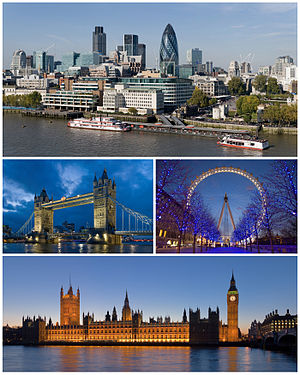








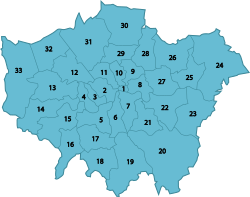



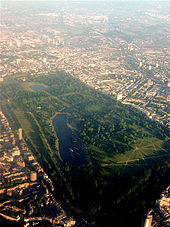
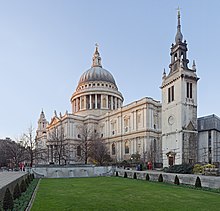
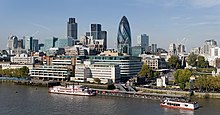

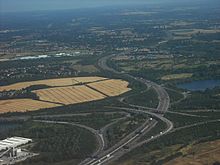
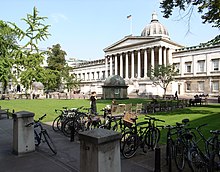


0 comments
boleh komen ,asal pakai hati ya...dan blog ini sudah dofollow
note:blog ini tidak membatasi orang yang berkomentar dengan nama Anonymous, seperti blog yang lain,jadi silahkan berkomentar sesuka hati ..!